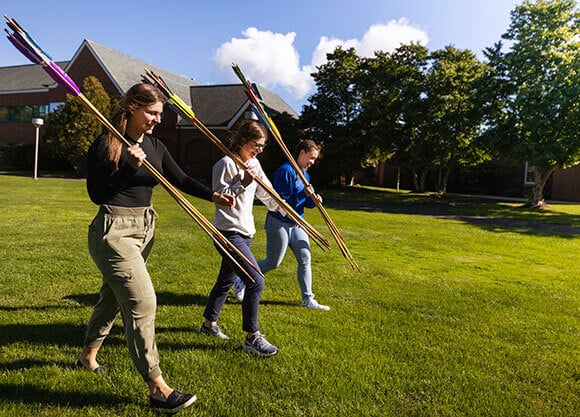
Learning by engaging with the past
November 05, 2021

November 05, 2021

The course is popular not only with anthropology minors but also across the university as a popular general education course. The course offers a hands-on introduction to studying the history of humanity for all students.
“What I found over the years is that hands-on activities are a fun way to be engaged with the past and also a way to appreciate the skillsets and knowledge of past people,” said Associate Professor of Anthropology Julia Giblin.
Throughout the semester, students are introduced to the physics of how tools were made during the Paleolithic Era, also referred to as the Old Stone Age. Giblin sources chert, obsidian and flint online to give students the chance to shape their own arrowheads and other instruments.
“As a society, we tend to think we have it figured out and that our technology is so sophisticated. We have been a species for the last 200,000 years and we have been as smart as we are now those years ago,” said Giblin. “A society’s technology fits its current lifestyle and environment.”
During flint-knapping week, Giblin takes a different approach in the classroom. Students read a posted lecture before class and spend in-class time shaping their tools. Prior to COVID-19, Giblin hosted the workshop in a research lab on campus, moving the exercise outside makes the experience more authentic, she explained.
Students are supplied with a lengthening tool replicating our ancestors' instrument to fortify spears and extend reach. Once they are ready to hunt, students take aim at a life-size cut out of a wooly mammoth, a gift from past students.
“Students are surprised at how hard it is and come away with an appreciation for our ancestors. Societies of hunters and gatherers still use stone tools today as well, such as the Inuits in Alaska,” said Giblin.
Giblin delves further into archaeological implications of stone tools in the upper-level courses she teaches. Students study artifacts excavated from the New Haven area in the 1970s. Items are often covered with layers from colonial contact when the English arrived in the 1600s, said Giblin. Some artifacts date back 8,000 years.
“We explore what it is about these locations that inspired tribes to live where they did for as long as they did. I try to connect the learning to the Quinnipiac people and their land so students can gain a deep understanding of the indigenous connection,” she said.
Quinnipiac Today is your source for what's happening throughout #BobcatNation. Sign up for our weekly email newsletter to be among the first to know about news, events and members of our Bobcat family who are making a positive difference in our world.
Sign Up Now